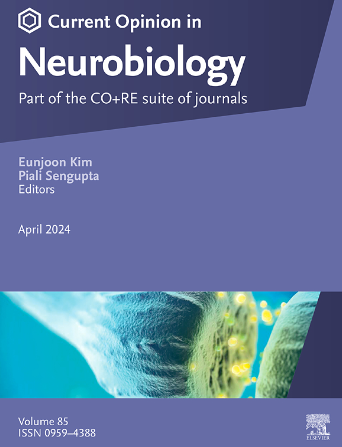电路形成和可塑性中神经元活动依赖性基因程序的染色质调控
IF 5.2
2区 医学
Q1 NEUROSCIENCES
引用次数: 0
摘要
神经元活动依赖性转录对神经元回路的发育和可塑性至关重要。在染色质水平上,神经元活动调节基因的诱导是通过多种机制进行的,包括组蛋白修饰在调控元件上的沉积、转录激活因子和抑制因子的结合、染色质重塑以及三维基因组结构的控制。在这里,我们回顾了我们目前对染色质机制如何调节神经元刺激后暂时不同的转录波的理解,并允许神经元安装细胞类型特异性和刺激特异性转录反应。我们还强调了发育神经元的特定表观遗传机制,该机制使即时早期基因(IEGs)保持在非活性状态,同时准备它们在响应感官刺激时快速激活。我们讨论了染色质调控机制如何在控制活性调控基因表达中发挥关键作用,从而在神经回路发育和可塑性的不同阶段实现精确的基因表达程序。本文章由计算机程序翻译,如有差异,请以英文原文为准。
Chromatin regulation of neuronal activity-dependent gene programs in circuit formation and plasticity
Neuronal activity-dependent transcription is crucial for the development and plasticity of neuronal circuits. At the chromatin level, the induction of neuronal activity-regulated genes is orchestrated through various mechanisms, including the deposition of histone modifications at regulatory elements, the binding of transcriptional activators and repressors, chromatin remodeling, and the control of 3D genome architecture. Here, we review our current understanding of how chromatin mechanisms regulate temporally distinct transcriptional waves following neuronal stimulation and allow neurons to mount cell type-specific and stimulus-specific transcriptional responses. We also highlight a specific epigenetic mechanism in developing neurons that maintains immediate early genes (IEGs) in an inactive though poised state, while simultaneously preparing them for rapid activation in response to sensory stimulation. We discuss how chromatin regulation mechanisms play a crucial role in controlling activity-regulated gene expression, enabling the implementation of precise gene expression programs during different stages of neural circuit development and plasticity.
求助全文
通过发布文献求助,成功后即可免费获取论文全文。
去求助
来源期刊

Current Opinion in Neurobiology
医学-神经科学
CiteScore
11.10
自引率
1.80%
发文量
130
审稿时长
4-8 weeks
期刊介绍:
Current Opinion in Neurobiology publishes short annotated reviews by leading experts on recent developments in the field of neurobiology. These experts write short reviews describing recent discoveries in this field (in the past 2-5 years), as well as highlighting select individual papers of particular significance.
The journal is thus an important resource allowing researchers and educators to quickly gain an overview and rich understanding of complex and current issues in the field of Neurobiology. The journal takes a unique and valuable approach in focusing each special issue around a topic of scientific and/or societal interest, and then bringing together leading international experts studying that topic, embracing diverse methodologies and perspectives.
Journal Content: The journal consists of 6 issues per year, covering 8 recurring topics every other year in the following categories:
-Neurobiology of Disease-
Neurobiology of Behavior-
Cellular Neuroscience-
Systems Neuroscience-
Developmental Neuroscience-
Neurobiology of Learning and Plasticity-
Molecular Neuroscience-
Computational Neuroscience
 求助内容:
求助内容: 应助结果提醒方式:
应助结果提醒方式:


